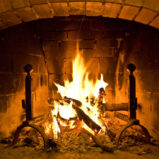|
Devastating house fires can happen in an instant, and many begin due to human error. The U.S. Fire Administration reports that cooking tops the list of residential building fire causes (50 percent), followed by heating equipment (12.5 percent) and electrical malfunction (6.3 percent).
Make your fall and winter seasons merry, bright and fire-free with these essential fire safety tips.
- Schedule a chimney inspection at least once a year. Creosote, or condensed smoke, builds up on the flue and can catch fire. An annual cleaning and inspection can help prevent chimney fires.
- Keep flammable items at least three feet from heat sources. According to the National Fire Prevention Association, 56 percent of fatal home heating fires ignite from items being placed too close to heating equipment. Make sure everything is a safe distance from heat sources, including the furnace, space heaters, fireplaces and wood stoves.
- Check smoke detectors frequently. Approximately 60 percent of house fire deaths happen in structures with no working smoke alarms. Test your home’s smoke alarms monthly and replace batteries each year.
- Have a family escape plan and practice it regularly. All household members need to know all exit strategies in case a fire breaks out, as well as where to meet once they’re safely outside. Have a semiannual drill and practice at different times of the day.
- Cook safely. Never leave the room when boiling, frying or baking, keep pot holders and dish towels away from the flame, and immediately turn off appliances when not in use.
- Be mindful of holiday decorations. If you choose to decorate with strings of lights, always check their condition first. Throw out those with exposed electrical wiring, and be sure to read over the manufacturer’s instructions.
|


![Young couple hugging on sofa in front of fireplace at home, rear view. Click here for more "People at Home" images: [url=my_lightbox_contents.php?lightboxID=1507925][img]http://www.nitorphoto.com/istocklightbox/peopleathome.jpg[/img][/url]](https://1431realestate.com/wp-content/uploads/2016/10/fireplacecouple.jpg)


